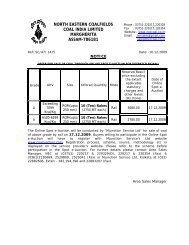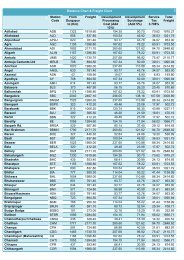India's largest coal handling agency - Mjunction
India's largest coal handling agency - Mjunction
India's largest coal handling agency - Mjunction
You also want an ePaper? Increase the reach of your titles
YUMPU automatically turns print PDFs into web optimized ePapers that Google loves.
Feature<br />
Allocattees pulled up for<br />
inordinate delay<br />
Peeved at the dismal progress, the <strong>coal</strong> ministry has<br />
pulled up existing <strong>coal</strong> block allocattees, both public<br />
and private, for delay in the development of captive<br />
blocks. Only last month, the ministry declared it has<br />
identified as many as 93 <strong>coal</strong> blocks where almost all the<br />
requisite milestones are pending. Of these, 45 belong<br />
to government sector companies and the rest 48 to the<br />
private sector.<br />
The list of these ‘laggards’ include large companies<br />
including NTPC, ArcelorMittal, Bhushan Steel, Monnet<br />
Ispat, Hindalco, Usha Martin and GVK Power, among<br />
others. Since September to date, the ministry has issued<br />
show cause notices to at least 31 block allocattees. Four<br />
blocks were even deallocated during the April to June<br />
period.<br />
“We want to enhance <strong>coal</strong> production of the country.<br />
For this, we can snatch the <strong>coal</strong> blocks back,” <strong>coal</strong><br />
minister, Sriprakash Jaiswal, has said.<br />
Recently, the <strong>coal</strong> ministry asked all captive block<br />
allocatees and joint venture companies (JVCs) to submit<br />
information about the status of captive blocks and<br />
associated end-use projects, to the Office of the Coal<br />
Controller and the ministry by October 15. This was part<br />
of the quarterly review exercise conducted by the ministry<br />
to examine the progress made in the development of<br />
such blocks.<br />
In the last review meeting held between July 20 and<br />
July 21, 2010, it was decided that all the JVCs will collect<br />
the status reports of <strong>coal</strong> blocks and their associated enduse<br />
projects of individual block allocatees and submit the<br />
same to the Office of the Coal Controller at the end of<br />
every quarter.<br />
It means these 25 <strong>coal</strong> blocks would now be allotted<br />
through bidding route.<br />
The system of allotment of captive <strong>coal</strong> blocks to private<br />
and government companies was introduced way back in 1993<br />
and since then, 215 such blocks with estimated geological<br />
reserves of about 50 billion tons have been allotted to about<br />
310 public and private sector companies in power, steel,<br />
sponge iron, cement and fertiliser sectors.<br />
However, of the total blocks allocated so far, around<br />
8 blocks have been cancelled by the <strong>coal</strong> ministry as the<br />
entities to whom these blocks were allotted had violated<br />
various terms and conditions of the allotment. Out of the total<br />
blocks allotted, around 100 <strong>coal</strong> blocks have been allotted to<br />
government companies with geological reserves of about 27<br />
billion tons and about 105 <strong>coal</strong> blocks have been allocated to<br />
private companies with geological reserves of about 18 billion<br />
tons. A number of blocks have also been allocated to Ultra-<br />
Mega Power Plants (UMPPS)<br />
At the beginning of the current Eleventh Plan or towards<br />
the end of the Tenth Plan (2006-07), it was envisaged that<br />
<strong>coal</strong> production from captive <strong>coal</strong> blocks would be increased<br />
substantially to around 117 million tons per annum (mtpa)<br />
from 2011-12 (terminal year of XIth Plan).<br />
Incidentally, production from captive <strong>coal</strong> blocks was to<br />
account for around 15 percent of the country’s <strong>coal</strong> requirement<br />
of around 731 mt that was earlier envisaged in 2011-12 (now<br />
reduced to 713 mt).<br />
However, it has been found that out of the total blocks<br />
allotted so far, only 26 have reached production stage and<br />
together they are producing around 30 mt of <strong>coal</strong> annually.<br />
The provisional production from 25 operational captive <strong>coal</strong><br />
blocks was around 34 mt in 2009-10.<br />
The production in 2008-09 stood at 30.02 mt. and the<br />
production from existing and upcoming captive <strong>coal</strong> blocks<br />
in the terminal year of the Eleventh Plan is estimated to<br />
be around 80.89 mt as per the mid-term appraisal held in<br />
September 2009.<br />
It is estimated that only about 5 more blocks would reach<br />
production stage by March 2011 and the rest of the blocks are<br />
far away from reaching that stage.<br />
In such a situation, the initial target of achieving production<br />
to the tune of around 117 mt <strong>coal</strong> from captive <strong>coal</strong> blocks in<br />
2011-12 seems impossible.<br />
According to an estimate of Coal Insights, the production<br />
from captive <strong>coal</strong> blocks at best could reach 70 mt by 2011-12<br />
even though the mid-term appraisal had put the figure at 80.89<br />
mt. Anything beyond 75 mt looks impossible at the moment.<br />
Reasons for delay in starting production from captive <strong>coal</strong><br />
blocks<br />
It has been found out that there are primarily six to<br />
seven reasons for delays in starting production from not<br />
only captive <strong>coal</strong> blocks, but also from blocks in possession<br />
of Coal India Ltd (CIL) and Singareni Collieries Company<br />
Ltd (SCCL).<br />
The first and foremost reason is the huge delay in<br />
acquisition of land and associated problems of rehabilitation.<br />
The second relates to delay in diversion of forest land and the<br />
third pertains to delay due to non-approving or permitting<br />
exploration in forest area.<br />
The fourth reason comprises delay due to adverse geomining<br />
condition and the fifth is delay due to fire. The sixth<br />
important reason for delay in starting new projects is due to<br />
the law and order situation.<br />
Additionally, there are other miscellaneous problems<br />
such as delay or discontinuance of work by contractor, non<br />
participation in tender, DGMS permission, and so on.<br />
It would be noteworthy to find whether this new system of<br />
COAL INSIGHTS 26 October 2010
















